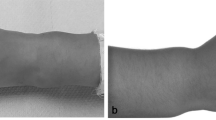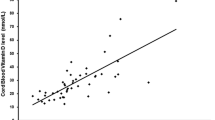Abstract
Congenital rickets in 3 newborns of mothers with advanced nutritional osteomalacia, healed with maternal breast milk feeding when mothers alone were given calcium supplements and 7.5 mg of intravenous D2 and the mother baby pair protected from sunlight. Maternal plasma biochemistry indicated more severe vitamin D deficiency compared to their newborns (intrauterine foetal priority). The first dose of 7.5 mg of vitamin D3 and calcium supplements to mother healed osteomalacia but did not appear to heal the rickets of their breast fed infants (extrauterine maternal priority for vitamin D). A second dose given at 3 months interval healed the rickets in their infants and the biochemistry of the mother and baby returned towards normal. Congenital rickets developed when maternal bone mineral and vitamin D stores had been completely exhausted. Raised IPTH levels in the newborn suggested that foetal parathyroids were responsive to hypocalcaemic stimulus.
Similar content being viewed by others
References
Maxwell JP, Hu CH, Turnbull HM. Foetal rickets.J Path Bact 1932; 35: 419–438.
Ford JA, Davidson DC, McIntosh WB et al. Neonatal rickets in Asian immigrant population.Br Med J 1973; 3: 211–212.
Moncrief M, Fadahunsi TO. Congenital rickets due to maternal vitamin D deficiency.Arch Dis Child 1974; 49: 810–811.
Teotia M, Teotia SPS. Maternal hypovitaminosis and congenital rickets.Bulletin, International Pediatric Association 1979; 3: 39–46.
Reisse E, Canterbury JM. A radioimmunoassay for parathyroid hormone in man.Proceedings of the Society for Experimental Biology and Medicine 1969; 128: 501–504.
Haddad J, Chyu KJ. Competitive protein binding radioassay for 25-hydroxycholecalciferol.J Clin Endocrinol 1971; 33: 992–995
King EJ. In: Wootton IDP, ed.Microanalysis in Medical Biochemistry, 4th ed. London: Churchill Livingstone, 1964; 101–103.
Fiske CH, Subbarow Y. Inorganic phosphorus determination in plasma and urine.J Biol Chem. 1925; 66: 375–376.
Rao DS: Practical approach to biopsy. In: Rocker RR, ed.Bone Histomorphometry. Techniques and Interpretation. Florida: CRC Press, 1983; 3–11.
Erenberg A, Weinstein MM, Chen IW, Tsang RC. Placental impermeability to parathormone I-125 in the ewe.Pediatr Res 1978; 12: 394–396.
Northrop G, Misenhimer HR, Becker FO. Failure of parathyroid hormone to cross the nonhuman primate placenta.Am J Obstet Gynecol 1977; 129: 449–453.
Author information
Authors and Affiliations
Rights and permissions
About this article
Cite this article
Teotia, M., Teotia, S.P.S. & Nath, M. Metabolic studies in congenital vitamin D deficiency rickets. Indian J Pediatr 62, 55–61 (1995). https://doi.org/10.1007/BF02752183
Issue Date:
DOI: https://doi.org/10.1007/BF02752183




